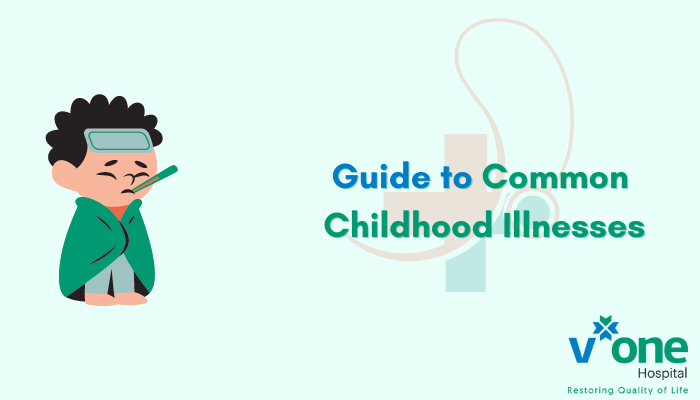5 Common Childhood Illnesses – Your Go-To Guide
Nobody has ever made it to adulthood without falling sick a bunch of times. A trip to the nurse’s office was a regular occurrence for some of us. But we always want our kids to have what we didn’t have – we want nothing but the best for them. And that includes better health.
So why do kids get sick so often? Well, at that age, their immune system is still developing. And as they mingle with other kids at daycare or at school all day, their immune systems are constantly being exposed to bacteria and viruses they’ve never seen before. This is why they keep getting sick and may infect others too. As they get older, they’ll fall sick less often. But as the parent of a rather young kid, you will want to keep them as healthy as possible. So here’s a list of the 5 most common childhood illnesses to keep an eye out for.
Common Childhood Illnesses to Look Out
1. Respiratory Tract Infections
The most common respiratory tract infections in children include upper respiratory tract infections like laryngitis, pharyngitis, sinusitis, epiglottitis, and the common cold, and lower respiratory tract infections like flu, viral bronchitis, bronchiolitis, and pneumonia.
Symptoms of a Respiratory Tract Infection
- Cough
- Fever
- Runny nose
- Sore throat
- Hoarse voice
- Chest pain
- Fatigue
- Shortness of breath
- Wheezing
- Low energy
- Red eyes
Since these are caused by viruses, antibiotics don’t help with respiratory tract infections (unless you have a bacterial infection), but you can treat the symptoms with painkillers, rest, and drinking fluids.
2. Ear Pain
Earaches are one of the most common childhood illnesses. In fact, kids under 5 have a higher risk for ear infections. The reason for an ear infection may be fluid behind the eardrum, an infection in the ear canal, or an infection in the middle part of the ear.
Ear pain can also be caused by teething or a sore throat.
Symptoms of Ear Problems in Children
- Ear pain
- Redness/swelling of outer ear
- Leakage from ear
- Trouble hearing
- Pulling or rubbing ears
- Crying and irritability
- Difficulty sleeping
- Ear fullness of popping
- Loss of balance
- Fussiness
- Vomiting
- Headache
- Fever
Getting the PCV and flu vaccines on time can reduce the risk of a middle ear infection, but properly washed hands will also keep them safe.
3. Fainting (Syncope)
Have you ever heard of a child falling from their seat for no reason? Well, sometimes, children may faint, and while it’s usually harmless, sometimes, it can indicate an underlying neurological or heart problem. When something causes a temporary lack of oxygen-rich blood to the brain, it can cause someone to faint. But it can also be caused by a sudden drop in blood pressure, a really fast or really slow heart rate, an irregular heart rate, structural heart disease, or a drop in blood pressure from a sudden change in position. But there can be a myriad of other reasons too.
Symptoms of Fainting
- Dizziness
- Nausea
- Lightheadedness
- Changes in vision
- Cold, damp skin
With so many causes why children faint, you won’t always be able to keep your child from fainting, but you will have enough warning signs before it happens, so they can sit or lie down before they faint to avoid injury. You should keep them lying down for 10-15 minutes or with their head between their knees and then give them a glass of water before seeing a doctor.
4. Abdominal Pain, Diarrhea, and Vomiting
Indigestion can cause pain and burning in the area between the breastbone and navel, or bloating in the upper abdomen. It usually goes away on its own, but smaller meals and a bland diet help. And while constipation can cause infrequent bowel movements, stomachache, bloating, or discomfort, stress, and anxiety can trigger abdominal cramps and discomfort. Stomach flu can cause a list of problems like watery diarrhea, abdominal cramps, nausea, and vomiting. Although other times, it can be appendicitis or internal obstruction.
5. Skin Infections (Eczema)
At least 1 in 10 children have eczema, also called atopic dermatitis. It makes their skin all red, itchy, dry, bumpy, and irritated.
Symptoms of Eczema in Infants
- A rash on cheeks, forehead, or scalp
- The rash may spread to the knees, elbows, and trunk
Symptoms of Eczema in Older Kids and Teens
- A rash in the bends of elbows, behind the knees, on the neck, or on the inner wrists and ankles
- Dry and scaly skin
- Thicker, darker, or scarred skin
Irrespective of childhood illnesses, catching the signs early on can help you deal with them better and improve your child’s chances for recovery.

